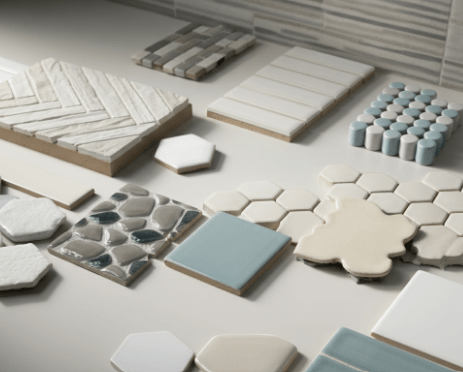Transforming a compact bathroom into a stylish and functional space can be a delightful challenge. Carefully selecting tiles can significantly boost your compact bathroom’s aesthetic charm and functionality. This blog will explore Small Bathroom Tiles Design ideas that can turn even the tiniest bathroom into a stunning retreat. From clever patterns to innovative materials, our top 10 small bathroom tiles design picks will help you create a beautiful and practical space. Whether you prefer a minimalist aesthetic or a more extravagant décor, these tile designs will inspire your next renovation project.
Real estate investors Steve Daria and Joleigh understand the transformative power of well-chosen bathroom tiles in small spaces. They have successfully used a variety of tile designs in their properties to enhance aesthetic appeal and functionality. Drawing inspiration from their expertise, we’ll explore the top 10 small bathroom tile designs that can make any compact bathroom feel luxurious and spacious.
1. Opt for Light Colors
For your small bathroom tiles design, light colors craft an illusion of space, making your bathroom appear more extensive and open.
They reflect more light, contributing to an airy and spacious feel.
Tips for Using Light Colors
- Choose white, beige, or pastel shades for your tile design.
- Incorporate glossy finishes to enhance light reflection.
- Utilize light-colored grout to maintain a seamless look.

2. Go for Large Tiles
Large tiles minimize the number of grout lines, resulting in a more continuous and expansive appearance.
This can make your small bathroom seem larger and less cluttered.
Tips for Using Large Tiles
- Select tiles that are at least 12×24 inches in size.
- Lay tiles in a diagonal pattern to create visual interest and elongate the room.
- Opt for rectified tiles to minimize grout lines.
3. Vertical Stripes
Vertical stripes with the eye in an upward direction create the illusion of height and make your small bathroom feel taller and more spacious.
Tips for Using Vertical Stripes
- Incorporate vertically striped tiles on one or more walls.
- Combine different shades of the same color for a subtle effect.
- Coordinate the stripes with fixtures to establish a cohesive look.
4. Mosaic Tiles
For your small bathroom tiles design, mosaic tiles add texture and visual appeal to your bathroom, serving as a focal point or accent in specific areas such as the shower niche or backsplash.
Tips for Using Mosaic Tiles
- Select mosaics with small patterns to maintain design cohesion.
- Use mosaic tiles sparingly to prevent overwhelming the space.
- Incorporate glass or metallic mosaics for a touch of luxury.
5. Use Reflective Materials
Reflective materials like glass or metallic tiles can enhance light in your bathroom, creating the illusion of a larger and brighter space.
Tips for Using Reflective Materials
- Integrate mirrored tiles for a modern and chic aesthetic.
- Include metallic accents in the tile design.
- Combine reflective tiles with light colors for maximum impact.
Get An Offer Today, Sell In A Matter Of Days
6. Create a Feature Wall
A feature wall can draw attention to a specific area, diverting focus from the bathroom’s small size and creating a focal point.
Tips for Creating a Feature Wall
- Opt for bold or patterned tiles for the feature wall.
- Position the feature wall behind the vanity or bathtub for optimal effect.
- Balance the feature wall with neutral tiles on other walls.
7. Use Subway Tiles
Subway tiles offer a classic choice that can make a small bathroom look timeless and elegant.
Their rectangular shape can elongate the space, mainly when laid in a horizontal pattern.
Tips for Using Subway Tiles
- Choose white or light-colored subway tiles.
- Arrange tiles in a brick pattern for a traditional appearance.
- Utilize contrasting grout to emphasize tiles and add depth.
8. Incorporate Geometric Patterns
Geometric patterns can add a modern look to your bathroom while creating the illusion of space.
They can be utilized in various ways to enhance the overall design.
Tips for Using Geometric Patterns
- Select tiles with geometric shapes like hexagons or diamonds.
- Implement patterns in specific areas, such as the floor or backsplash.
- Combine geometric patterns with plain tiles for a balanced design.

9. Go for a Monochromatic Scheme
A monochromatic color scheme can create a symmetrical and cohesive look, making your small bathroom appear more spacious and unified.
Tips for Using a Monochromatic Scheme
- Select a single color and incorporate different shades and textures.
- Include various finishes such as matte, glossy, and satin.
- Use accessories in the same color palette to complete the look.
10. Add Accents with Bold Colors
Using bold colors as accents can inject personality and vibrancy into your bathroom without overwhelming the space.
They can be employed strategically to highlight specific areas.
Tips for Using Bold Colors
- Select bold tiles for the backsplash or shower niche.
- Pair bold accents with neutral tiles to maintain balance in the design.
- Use bold colors sparingly to create a striking effect.
Conclusion
This article’s small bathroom tiles design ideas offer practical solutions for transforming your small bathroom into a stylish, functional space that maximizes its potential. These small bathroom tiles design strategies enhance your small bathroom’s visual appeal and functionality. Carefully selecting tile sizes, patterns, and finishes can optimize space utilization and simplify maintenance.
Whether you’re looking to update a guest bathroom, enhance a rental property, or improve your living space, these creative tile design ideas offer versatile solutions with various design preferences and practical needs. With thoughtful planning and execution, you can achieve a stunning small bathroom that has served its purpose effectively for years.
**NOTICE: Please note that the content presented in this post is intended solely for informational and educational purposes. It should not be construed as legal or financial advice or relied upon as a replacement for consultation with a qualified attorney or CPA. For specific guidance on legal or financial matters, readers are encouraged to seek professional assistance from an attorney, CPA, or other appropriate professional regarding the subject matter.

